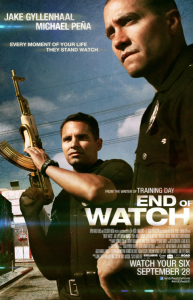
 Just who is the gangster? Writer/director David Ayer explores this question within the familiar confines of a cop film. There is a scene in the movie in which one police officer confronts a rowdy gang member and the two go toe-to-toe. Later the gang member explains to his homies that his encounter with the officer was straight up gangster. “End of Watch” is all gangster on the inside, while clothed in an uncomfortable uniform.
Just who is the gangster? Writer/director David Ayer explores this question within the familiar confines of a cop film. There is a scene in the movie in which one police officer confronts a rowdy gang member and the two go toe-to-toe. Later the gang member explains to his homies that his encounter with the officer was straight up gangster. “End of Watch” is all gangster on the inside, while clothed in an uncomfortable uniform.
Following two young cops as they patrol the streets of South Los Angeles, “End of Watch” feels very much like a movie we seen before. Think “Colors” or even more recently “Rampart.” The main difference early on is the visual scope. While not quite a found footage film, Ayer utilizes found footage techniques crossing them with traditional moviemaking. Little explanation is provided for this hybrid filmmaking approach. What explanation we do get comes when one of the young cops, Brian Taylor (played by Jake Gyllenhaal), explains that he is taking classes in college and has decided to document his job as part of a filmmaking course. In addition to carrying around a camcorder, he outfits himself and his partner, Mike Zavala (played by Michael Pena), with clip-on cameras attached to their uniforms. Much of the film is told from this perspective and the camerawork is of the “Cloverfield” variety.
But director Ayer is not content sticking with one point if view visually. He constantly cuts between all of the available cameras, including security cameras from the front of the police vehicle. The effect is inconsistent, at times unusual, and at others times unnecessary. The only reason that we the viewers get into this approach is because we are so used to watching YouTube and we have been exposed to the found footage thing until it has reached the over-saturation point. Recently, with the minor hit “Chronicle,” this technique was abused almost to the point its undoing. For me, the most frustrating thing during “End of Watch” was that the found footage hybrid efforts actually damaged more than they helped an otherwise good script and story. For much of the film, the shaky cam and grainy footage played more like a gimmick than like an integral part of the narrative.
Criticisms of the visual approach aside, “End of Watch” is sharply written and well acted. I especially liked the chemistry between Gyllenhaal and Pena. Both actors have already proven themselves to be capable of creating memorable characters, but here they are given the opportunity to have a lot of fun on camera. At times, it seems they are having more fun then the audience is. This is a bit of a problem during extended party scenes but can be forgiven as the movie reaches its action-packed conclusion. In fact, as the film drew to a close, I had the requisite lump-in-the-throat that Ayer was going for because the bromance was patiently developed early on.
The other breath of fresh air was that these are two good cops. Instead of displaying the LA Police Department as a bunch of corrupt hooligans, we are given a couple of good, likable guys that just want to do their job, learn some things, help people, and go home to their families. Compare last year’s “Rampart” in which Woody Harrelson played an out-of-control, corrupt, dinosaur cop who really need to be retired. Certainly, we’ve seen too many Bad Lieutenants. That isn’t to say that the cops featured in this film aren’t gangster. They clearly are, and it is their gangster tendencies that manage to keep them out alive and make them so good at what they do. While we’ve seen this kind of thing before, we’ve never seen it quite this way. It’s possible to do good and be gangster. And that points up the internal conflict that the visuals have with the narrative in this film. “End of Watch” is a good film on the inside trapped in an ugly wrapper.
